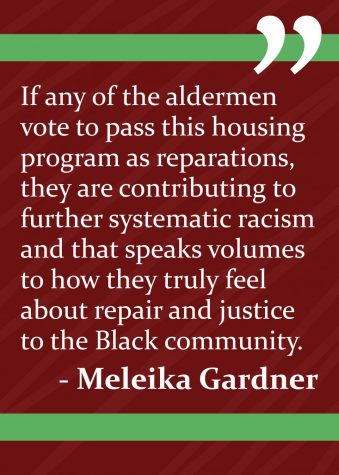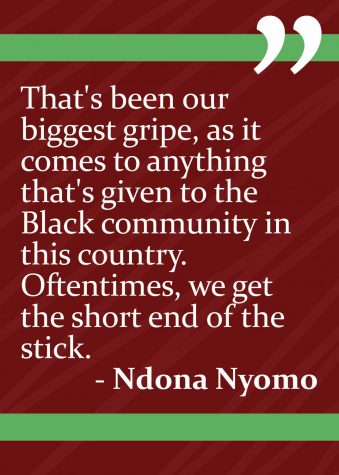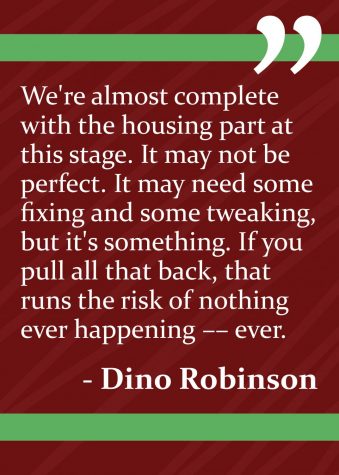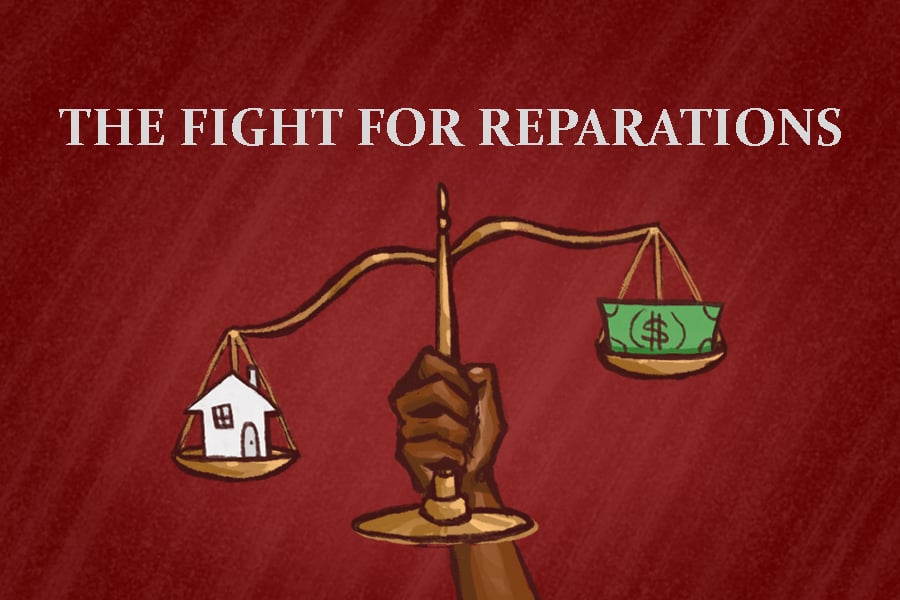In Focus: With the eyes of a nation on Evanston, the first step of the historic reparations program faces pushback
March 12, 2021
On a December day in 2019, hundreds of Evanston residents sang, cheered and cried together in the pews of the First Church of God in celebration of the first funded Black reparations program in the city — and in American history.
“It was a special moment for our city,” said Ald. Robin Rue Simmons (5th), who has led city reparations initiatives. “That meeting was really the convening of what is a lifetime of work ahead of us.”
Evanston City Council had just passed a resolution allocating $10 million dollars over 10 years from cannabis city tax revenue to a Black reparations fund. The legislation was the first in the country — on a local, state or federal level — to commit public funding to reparations for Black Americans. Upon its passage, Evanston garnered national attention for its commitment to addressing over a century of discrimination.
The bill proposes reparations through housing assistance and economic development programs, in efforts to redress redlining and other discriminatory housing policies. In contrast, the proposed federal reparations bill HR-40 targets reparations for slavery.
City Council will vote on March 22 on a plan to use the first $400,000 of the reparations fund toward housing grants. But some residents are critical — and their push against this historic first step is coming to a head.

Third-generation Evanston resident Rose Cannon, along with former mayoral candidate Sebastian Nalls and others, formed Evanston Rejects Racist Reparations, or E3R, on Feb. 28, to oppose the $400,000 Restorative Housing Reparations program. The group is new, but its leaders say they are raising issues residents have voiced since initial talks around reparations.
Cannon and others in E3R question why reparations should involve banks, which have hands in both Evanston’s history of redlining and the city’s current housing economy. They are also concerned about who will be prioritized, especially considering eyes around the country are watching Evanston as the first model for Black reparations.
“If any of the aldermen vote to pass this housing program as reparations, they are contributing to further systematic racism and that speaks volumes to how they truly feel about repair and justice to the Black community,” community activist and founder of Evanston Live TV Meleika Gardner said.
In a city known for its liberal politics, there has been little public debate on whether or not reparations should exist at all. But now, residents like Gardner are raising pointed questions ahead of a monumental vote about how the first $400,000 of reparations should be distributed.
A focus on housing
Before City Council approved the city’s reparations fund, initial community discussions on reparations led by the city’s Equity and Empowerment Commission centered around declining rates of Black homeownership in Evanston.
In several June 2019 meetings, community members were asked “what reparation means to our city,” according to Rue Simmons. She said many of the responses touched on the impacts of anti-Black city policies, such as home relocation, over-assesment of property taxes, contract sales and other acts of housing discrimination.
Rue Simmons said community input served as the foundation for the resolution she would go on to introduce. In November it passed, and in December the community rejoiced.
“(The initial meeting) was exciting and everybody was celebrating,” Gardner said. “And Robin, I don’t know if she was just telling us what we wanted to hear, but we were behind her 100%.”
After the initial meeting in late 2019, Rue Simmons got to work, joined by Ald. Ann Rainey (8th) and Ald. Peter Braithwaite (2nd) on a newly-formed reparations subcommittee.
With input from the National African-American Reparations Commission and the National Coalition of Blacks for Reparations in America, the reparations subcommittee released a July 2020 proposal recommending the first $400,000 of the $10 million go toward boosting Black home ownership in Evanston.
Evanston is a shifting city. Though Black residents comprised 22.5 percent of Evanston in 2000, today they make up about 16 percent — a number that has been on the decline. Ndona Nyomo, the president of Our Village the Black Evanstonian, said increases in cost of living as well as an increased violence can explain why so many Black residents have moved out.
The reparations subcommittee’s initial $400,000 initiative, the Restorative Housing Reparations program, aims to address this declining Black population, as well as the harm of over 100 years of discriminatory housing policy and redlining in Evanston. It would grant up to $25,000 to qualifying Black residents for home improvement, mortgage assistance, or as downpayment on an Evanston home.
The program aims to financially assist Black residents who “suffered discrimination in housing as a result of City ordinance, policy or practice, or are direct descendents of a Black Evanston resident who lived in Evanston between 1919 to 1969,” according to the city’s drafted proposal.
“We have a visible disparity,” Rue Simmons said. “Although we have data and diversity that shows an inclusive city, we have a segregated community. And we have a Black community that has on average $46,000 less in household income, less of a homeownership rate, less of an opportunity.”
Dr. Ron Daniels, the convener and administrator of NAARC, worked closely with Rue Simmons to establish a program in Evanston that met all of the federal organizations’s criteria for what a municipal reparations program should look like.
“She was already ahead of the curve in terms of doing town hall meetings and hearing what people wanted to do, and housing, housing, housing kept coming up,” Daniels said.
But some residents recall the beginning stages of reparations differently, saying that initially, Rue Simmons said residents would receive cash payments. According to lifelong Evanston resident Tina Paden, at 2019 Equity and Empowerment meetings, Rue Simmons referred to residents receiving “checks” as their payment. Cannon remembers this too.
Rue Simmons did tell WBEZ in a December 2019 interview she intended for the reparations program to be “a direct payment to residents that qualify.” But she maintains there wasn’t a defined form of payment in the beginning.
“In February of 2019, when I made the introduction, I was envisioning repair,” Rue Simmons told the Daily. “Cash payment, down payment assistance, business grant, education, it wasn’t defined yet.”
Kamm Howard, the national male co-chair for N’COBRA, told the Daily that Rue Simmons was instructed early on to avoid language citizens would associate with cash payments.
Howard said people assume “direct payments” refers to receiving checks, while Rue Simmons most likely meant “direct benefits,” or a service that goes directly to an individual.
Instead of checks, the subcommittee’s drafted plan restricts the first $400,000 in the reparations plan toward housing, with the remaining $9,600,000 undetermined.
But residents’ problems with the reparations subcommittee’s plan extend beyond the alleged change-of-tune from Rue Simmons.
“Reparations is a repayment of harm, why are you telling me what to do with the reparations money?” Tina Paden asked, in reference to the Restorative Housing Reparations program. “That’s discrimination on discrimination.”
A call for cash payments
As the first funded reparations initiative in the country, community members say the Evanston program faces intense pressure to succeed — and they want to get it right.
“All of a sudden it went from being this hopeful thing for so many people, to that first $400,000,” Gardner said. “The country is watching Evanston right now in terms of reparations, so you want that first $400,000 out the gate to be strong and make a statement that reparations is possible.”
Although the housing initiative is only 4 percent of the total $10 million in cannabis tax revenue pledged toward reparations, some residents want to scrap the housing plan altogether.
One reason residents like Gardner oppose the housing plan is banks’ history of discrimination against Evanston’s Black communities.
Black residents have historically been subject to mortgage discrimination in Evanston, according a Shorefront Legacy Center report. Banks routinely denied loans to Black residents looking to purchase or build homes in areas not marked as “acceptable” for them. They often steered Black people to the west end of the Fifth Ward instead.
In the 1940s, banks charged higher interest rates on Black-owned Evanston homes than on White-owned homes. And as recently as the 1970s, Evanston banks denied mortgages to Black residents, forcing them to get mortgages outside the community
Cannon worries the housing program benefits these historically discriminatory banks.
“The banks have been the ones who have profited the most for all these years and years of subjugation of my people here in this town,” she said.
E3R is now mobilizing Evanston residents to pressure their aldermen to vote against the first reparations initiative, or delay the vote until the new City Council takes office in the spring.
They argue that a “lame-duck” City Council shouldn’t vote on reparations, even if it’s only the first $400,000 of a $10 million fund.
“This is not what the people of Evanston want,” former Evanston mayoral candidate Lori Keenan said at a demonstration held by E3R. “Three of the aldermen who would potentially be voting, two of them have already lost their elections and one of them is already stepping down. On a Council of 9 people, there is no reason to rush this program.”
Beyond issues with the banks, opponents of the reparations housing program point to historical reparations efforts as reason for cash payments.
The federal government in 1998 dispersed about $1.6 billion dollars, $20,000 each, to survivors of Japanese internment camps.
Japanese American citizens received direct payments. Meanwhile, Black Evanston residents, Nyomo said, are being offered “social services.”

“That’s been our biggest gripe, as it comes to anything that’s given to the Black community in this country. Oftentimes, we get the short end of the stick,” Nyomo said.
Tina Paden’s sister, Renee Paden, also pointed to the order in which the reparations for Japanese Americans were given out — with the eldest survivors first.
“Groups in the past, when they received reparations they received a cash payment,” Tina Paden said. “They didn’t say go over here and buy a house, and that’s your payment.”
Prioritizing those most harmed
The Paden sisters live on Emerson St. in their late mother’s childhood home, which was built in the late 1800s by their grandmother’s uncle.
The sisters, who are landlords at Paden Properties, said the reparations program should prioritize seniors, who have experienced the most harm from discrimination and redlining.
“We know our seniors,” Tina Paden said. “They’re on a fixed income, they have social security, if they don’t already own their own home, some of them have already lost their homes and they don’t want to buy another home.”
Renee Paden, who was born in 1963 and is eligible for the program, said reparations should be given first to those who were adults at the time of injury.
“I don’t believe I deserve reparations before my elders,” Renee Paden said. “I suffered harm but my harm was minimal compared to my elders. So why are the elders being ignored by throwing this housing program on them, which don’t fit any of them?”
But Rue Simmons has maintained that seniors will benefit from the plan, and told The Daily she will prioritize those who lived in Evanston before 1969, as well as direct descendants, in the program.
“There are seniors in town that do own homes that are burdened by the cost of them,” Rue Simmons said in a January reparations subcommittee meeting. “There are seniors that are looking forward to participating in the reparations program to get some relief.”
A ‘bona fide’ reparations program
Despite criticism from some residents, the national response to the initiative has been widespread praise. Rue Simmons has spoken at national reparations forums, been featured on ABC’s “Soul of a Nation,” and has had Evanston’s plan certified by national organizations as a model for the country.
N’COBRA and NAARC, founded in 1987 and 2015, respectively, both advocate for reparatory justice for Black Americans.
Howard, of N’COBRA, said fighting this one initiative “is not productive to the movement in general.” While banks have a history of discrimination, it is virtually impossible to circumvent them when buying a home. This initiative, he said, grants “instant wealth” by aiding the purchase of a home.
He fears too many Evanston residents are “short-sighted,” and worries delaying the process any further is unfair to those waiting on repair. He added he believes a local fund does not have the resources to distribute cash payments large enough to be anything more than symbolic.
According to an estimate by the Chicago Metropolitan Agency for Planning, Evanston’s Black population was approximately 12,155 between 2014-2018. If the $10 million were divided up, each resident would receive a one-time payment of $822.70 not accounting for age requirements, a figure Howard and other Restorative Housing Reparations organizers doubt would make any meaningful impact.
In August 2020, a month after the subcommittee released their draft for the Restorative Housing Reparations Program, NAARC certified the city’s plan as a national model.
“We see ourselves as an authoritative body that looks at the criteria, looks at the process and certifies that this is a bona fide (reparations),” NAARC’s Daniels said. “Evanston met all the criteria and all of the principles that are important in terms of a local or municipal reparations initiative.”
An authority of stakeholders
Several residents have also raised another notable issue: who, if anyone, is qualified to represent the Black community in the reparations process?
One of NAARC and N’COBRA’s roles in advising the Evanston reparations plan was determining whether it met the criteria for “legitimate reparations,” one of them being that the injured party determines the remedy and directs the resources.
To achieve that goal, the reparations subcommittee made plans to appoint four Black community leaders, or “stakeholders,” that will work with the subcommittee to direct and recommend uses of the reparations fund.
But Gardner said she believes the community leaders should be elected by the Black community, rather than appointed by the mayor.
At the same time, local Black historian Dino Robinson is also working to establish an independent group of stakeholders along with Rev. Michael Nabors and Pastor Monté Dillard through the Evanston Community Foundation. The group of stakeholders plans to create its own reparations fund apart from the city, funded entirely by private donations.
Robinson, among others, has advised Rue Simmons on the reparations program since 2019. Rue Simmons said his 77-page report on Evanston’s history of anti-blackness served as evidence of a need for a housing-centered reparations initiative.
Robinson said the reparations subcommittee’s policy recommendations will be informed by the RSAE, and that the RSAE will suggest Black community leaders to serve on the city’s subcommittee.
But residents such as Cannon and Gardner worry a stakeholders authority, which is intended to be made up of leaders of Black organizations from around the community, won’t truly represent Black Evanston residents.
“(Rue Simmons) was approaching who she thought were Black leaders in the community that would be palatable to the whole community to speak for them,” Cannon said, referring to the 2019 First Church of God meeting. “You will have to speak to me and I will tell you how I want to be repaired.”
Nabors, the president of the Evanston NAACP and the senior pastor at the Second Baptist Church of Evanston, argued that the organizers of the stakeholders group are some of the most important leaders in the Black Evanston community.
“I represent a congregation that has 900 members and I would also feel very comfortable speaking on behalf of them,” Nabors said. “They are fully supportive of the effort of the stakeholders in the reparations movement so far.”
He added it would be “ludicrous” to say E3R represents the predominant opinion of the Black community in Evanston.
But Cannon, who works for Nabors as a member of his ministerial staff, said he doesn’t have the “authority” to speak for what she, or many other members of the church, think about reparations.
Former 2nd Ward Ald. Lionel Jean-Baptiste worked with Rue Simmons to put together the housing reparations initiative and serves as a standing member of NAARC.
He said, despite arguments that community leaders appointed to the subcommittee don’t adequately represent the Black community, it would be impossible for each Black resident to determine what their individual reparations look like.
“This is a city process,” Jean-Baptiste said. “Every commission or committee that deliberates over proposals to submit to the city (is) appointed by the mayor. It may be recommended, but ultimately, the mayor has to make that decision.”
The ‘road’ to reparations
Robinson said while the initial housing plan might not satisfy everyone, it’s only one component of the reparations process.

He expressed frustration that after almost two years, a “minority” of residents, like those of E3R, has come into the forefront of the issue to pull back something that he and other city leaders have worked hard to make a reality.
“We’re almost complete with the housing part at this stage,” Robinson said. “It may not be perfect. It may need some fixing and some tweaking, but it’s something. If you pull all that back, that runs the risk of nothing ever happening –– ever.”
Robinson emphasized that the housing reparations program is only a first step, and that “every start of something new and innovative starts small.” He said he likes to think of the process in terms of building a car: while one might look at an engine block and say it isn’t yet a car, it’s getting there.
“When you come back next week you’ll see a car in the frame,” Robinson said. “Don’t focus on just the engine being there, because we’re building that car.”
The Paden sisters however, argued that the housing reparations program isn’t true reparations because the money ultimately goes to the banks. Coincidentally, they did so through a car analogy of their own.
“It’s like somebody rams into your car,” Renee said, “And your car is totaled, and they say, ‘We’ll give you a down payment on the new car, but… you have to be able to qualify for this Lamborghini before you can get any of the fund — and it’s not going to you, it’s going to the dealer.’”
Amidst the opposition to the momentous step, and a group of community leaders who have worked painstakingly hard to get there, how the program will move forward remains up in the air.
Daniels, of NAARC, expressed optimism for the future of the program. Although he might not agree with those opposed to the housing initiative, he thinks the debate is healthy for making reparations as strong as possible.
“The debate is good. The process is good. It’s not perfect, but no process is going to be perfect,” he said. “It’s like Martin Luther King said, ‘the universe is long but it bends towards justice.’ Well, we are bending it. It is being bent towards justice, and Evanston is on a continuum of that arc towards justice.”
The original version of this article mischaracterized the relationship between the city government’s reparations subcommittee and the Reparations Stakeholders Authority of Evanston, a non-city entity. The story was updated to clarify this distinction. The Daily regrets this error.
Email: jasonbeeferman@u.northwestern.edu
Twitter: @jasonbeeferman
Related Stories:
— “Generations of pain”: The road to reparations in Evanston
— Community group seeks to delay vote on reparations they call “racist

